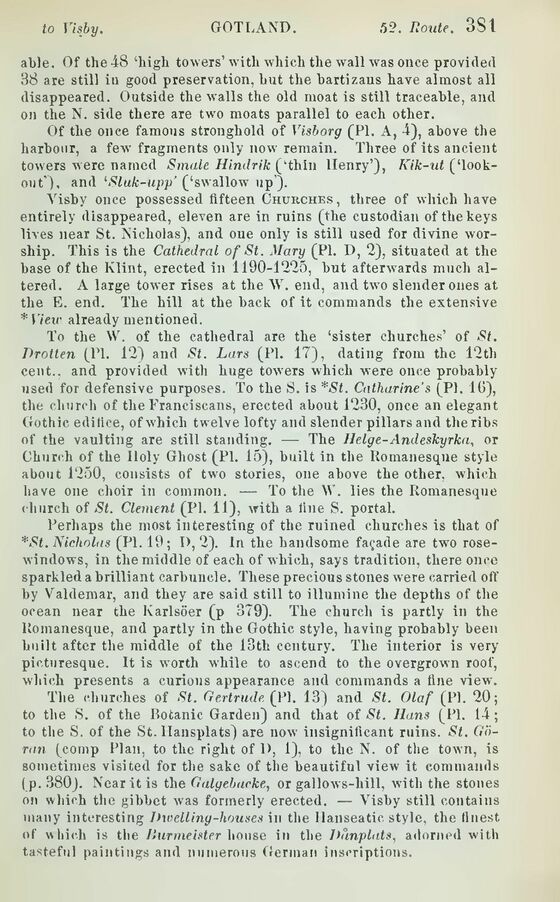
Full resolution (JPEG) - On this page / på denna sida - Sweden - Pages ...

<< prev. page << föreg. sida << >> nästa sida >> next page >>
Below is the raw OCR text
from the above scanned image.
Do you see an error? Proofread the page now!
Här nedan syns maskintolkade texten från faksimilbilden ovan.
Ser du något fel? Korrekturläs sidan nu!
This page has never been proofread. / Denna sida har aldrig korrekturlästs.
able. Of the 48 ‘high towers’with which the wall was once provided
38 are still in good preservation, hut the bartizans have almost all
disappeared. Outside the walls the old moat is still traceable, and
on the N. side there are twro moats parallel to each other.
Of the once famous stronghold of Visborg (PI. A, 4), above the
harbour, a few’ fragments only now remain. Three of its ancient
towers were named Smale Hindrik (‘thin llenry’), Kik-ut
(‘lookout’), and ‘Sluk-upp’ (‘swallow up’).
Yisby once possessed fifteen Churches, three of which have
entirely disappeared, eleven are in ruins (the custodian of the keys
lives near St. Nicholas), and oue only is still used for divine
worship. This is the Cathedral of St. Mary (Pl. D, 2), situated at the
base of the Klint, erected in 1190-1225, but afterwards much
altered. A large tower rises at the W. end, and two slender ones at
the E. end. The hill at the back of it commands the extensive
*Vieu- already mentioned.
To the W. of the cathedral are the ‘sister churches’ of St.
Drotten (PI. 12) and St. Lars (PI. 17), dating from the 12th
cent., and provided with huge towers which were once probably
used for defensive purposes. To the S. is *St. Catharine’s (PI. 16),
the church of the Franciscans, erected about 1230, once an elegant
Gothic edifice, of which twelve lofty and slender pillars and the ribs
of the vaulting are still standing. — The Helge-Andeskyrka, or
Church of the Iloly Ghost (PI. 15), built in the Romanesque style
about 1250, consists of two stories, one above the other, which
have one choir in common. — To the W. lies the Romanesque
church of St. Clement (PI. 11), with a line S. portal.
Perhaps the most interesting of the ruined churches is that of
*St. Nicholas (PI. 19; D, 2). In the handsome facade are two
rose-windows, in the middle of each of which, says tradition, there once
sparkled a brilliant carbuncle. These precious stones were carried off
by Valdemar, and they are said still to illumine the depths of the
ocean near the Karlsöer (p 379). The church is partly in the
Romanesque, and partly in the Gothic style, having prohably been
built after the middle of the 13th century. The interior is very
picturesque. It is worth while to ascend to the overgrown roof,
which presents a curious appearance and commands a fine view.
The churches of St. Gertrude. (PI. 13) and St. Olaf (PI. 20;
to the 8. of the Rotanic Garden) and that of St. Hans (PI. 14;
to the S. of the St. llansplats) are now insignificant ruins. St.
Go-run (comp Plan, to the right of D, 1), to the N. of the town, is
sometimes visited for the sake of the beautiful view it commands
(p. 380). Near it is the Galgebarke, or gallows-hill, with the stones
on which the gibbet was formerly erected. — Visby still contains
many interesting Dwelling-houses in the Hanseatic style, the IInest
of which is the liurmeister house in the Dånplats, adorned with
tasteful paintings and numerous German inscriptions.
<< prev. page << föreg. sida << >> nästa sida >> next page >>